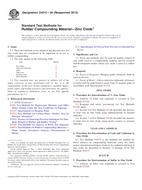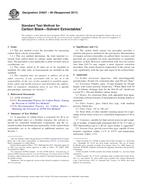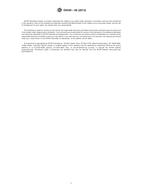We need your consent to use the individual data so that you can see information about your interests, among other things. Click "OK" to give your consent.
ASTM D4528-88(2012)
Standard Classification for Rubber Compounding Materials—Sulfur
STANDARD published on 1.5.2012
The information about the standard:
Designation standards: ASTM D4528-88(2012)
Note: WITHDRAWN
Publication date standards: 1.5.2012
SKU: NS-27593
The number of pages: 3
Approximate weight : 9 g (0.02 lbs)
Country: American technical standard
Category: Technical standards ASTM
The category - similar standards:
Annotation of standard text ASTM D4528-88(2012) :
Keywords:
insoluble sulfur, rhombic sulfur, sulfur , Chemical analysis--rubber chemicals/materials, Classification (standards)--rubber, Insoluble matter content--rubber, Rhombic sulfur, Rubber compounding materials, Sulfur--rubber, ICS Number Code 83.040.20 (Rubber compounding ingredients)
Additional information
| Significance and Use | ||||||||||||
|
Sulfur is one of the principal rubber vulcanizing agents. It is a critical additive. When chemically combined with rubber, sulfur develops basic performance properties in the vulcanized compound such as: tensile strength, elongation, modulus, and hardness. In soft or elastic rubber compounds, sulfur is an essential but minor additive. In semi-hard rubber and ebonite, sulfur becomes a major compounding material while retaining its role as a vulcanizing agent. The most stable molecular form of sulfur at ambient conditions is a ring structure containing eight sulfur atoms. Depending on conditions these molecules orient into one of two crystalline structures. At room temperature the crystals are rhombic and above 95°C they rearrange to monoclinic. Less than 1.5 % of either crystalline structure of sulfur is soluble in any rubber at room temperature. The second common molecular form of sulfur is polymeric sulfur, made up of unbranched chains of sulfur atoms. It is commonly referred to in the rubber industry as insoluble sulfur. When this material is created by rapid heating to above 160°C and quenching to room temperature, the sulfur is amorphous. If formed under other conditions, the polymer chains may develop regions of pseudo crystallinity. Insoluble sulfur is an important form of sulfur used only in the rubber industry. It is not soluble in any type of rubber hydrocarbon. When it is mixed in rubber, it disperses but remains undissolved in the rubber. The use of insoluble sulfur prevents the development of a supersaturated solution of sulfur in rubber that occurs when rhombic sulfur is used. No sulfur bloom will develop on the surface of uncured rubber pieces when the rubber cools after mixing or processing; therefore, building tack is preserved. At curing temperatures, insoluble sulfur rapidly transforms to a soluble species, dissolves in the rubber, and enters into the vulcanization process. |
||||||||||||
| 1. Scope | ||||||||||||
|
1.1 This classification covers the variety of sulfur grades used in the rubber industry. Typical chemical and physical properties for sulfur are shown. Sulfur is principally used in unsaturated rubbers as a vulcanizing agent. |
||||||||||||
| 2. Referenced Documents | ||||||||||||
|
Similar standards:
Historical
1.5.2012
Historical
1.5.2011
Historical
1.5.2012
Historical
1.5.2012
Historical
1.1.2009
Historical
1.5.2012
We recommend:
Updating of laws
Do you want to be sure about the validity of used regulations?
We offer you a solution so that you could use valid and updated legislative regulations.
Would you like to get more information? Look at this page.



 ASTM D4315-94(2012)..
ASTM D4315-94(2012).. ASTM D4527-99(2011)..
ASTM D4527-99(2011).. ASTM D4569-06(2012)..
ASTM D4569-06(2012).. ASTM D4571-06(2012)..
ASTM D4571-06(2012).. ASTM D4573-03(2009)..
ASTM D4573-03(2009).. ASTM D4574-06(2012)..
ASTM D4574-06(2012)..
 Cookies
Cookies
